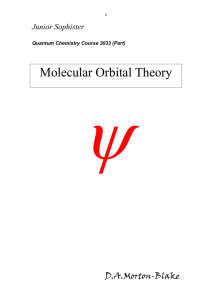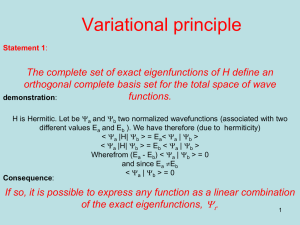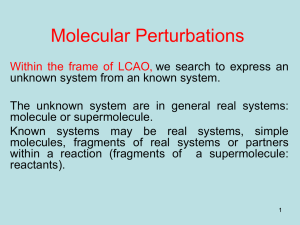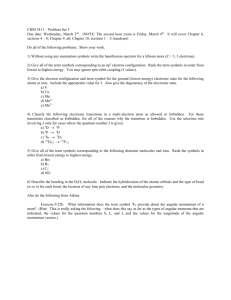MO theory
advertisement
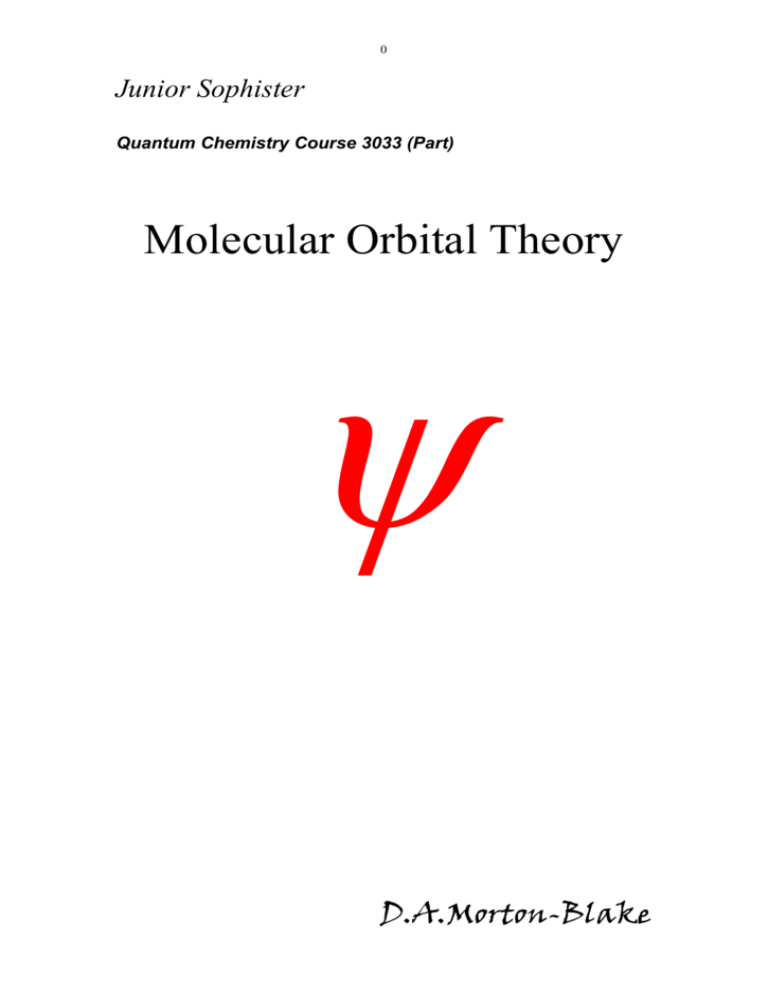
0
Junior Sophister
Quantum Chemistry Course 3033 (Part)
Molecular Orbital Theory
D.A.Morton-Blake
1
Molecular orbital theory
We have seen how the atomic orbital wave function provides a complete
description of the distribution of an electron in an isolated atom. As the wave
function (WF) (x,y,z) varies from one point in space to another, so does the electron
density function (x,y,z) (x,y,z)2. Remember too atomic orbital WFs come in
several different shapes and sizes. The s are spherically symmetrical, while p, d etc.
are directed in space. The p orbitals align along x, y, z, while the d point along and
between these axes.
Combination of orbitals
The function f(x) = ax + b is a linear function of x. If it were not for the
constant b it would be a simple proportionality f(x) = ax: the result of doubling x
would be to double f(x). (The constant b merely shifts the result by the same amount
whatever the value of x.)
A linear combination of functions means adding them together under the
control of mixing coefficients. If 1 and 2 are combined in this way,
= c11 + c22
the resulting function has characteristics derived from each of them. Their
respective weighting factors are decided by the coefficients c1and c2. The function
= c1(1)2 + c22 is not a linear function of 1 but it is a linear function of 2.
Let us first consider the combination of two atomic orbitals on the same atom.
If both are s orbitals such as 1s and 2s the resulting will obviously also have
spherical symmetry, i.e. it will be another s obital. If we combine two p orbitals, say a
px and a py the result is a p orbital that is directed intermediate between the x and y
directions. Next, combine two different kinds of orbitals such as an s and a px. The
result is an orbital which possesses characteristics of its component functions s and px.
This can be seen from the forms of the s and p orbital functions. First take the s
orbital s = er. This function is not directional: it depends solely on distance r from
the nucleus, and is therefore spherically symmetrical. The exponential form means
2
that the function is a maximum at the position of the nucleus and decays towards zero
with increasing r without ever reaching zero. The px orbital function is p = xer This
function too tends to zero at large distances from the nucleus, but the factor x
multiplying the function means that p is proportional to x, and therefore directed along
the x axis. It is positive for x > 0, negative for x < 0. The fact that it is zero at r = 0
means that the p function has a nodal plane running through the nucleus.
Next consider a mixing of the s and px orbitals in the ‘hybrid’ orbital sp:
sp = er + xer
This function also exponentially decays to zero with increasing r. Since the first term
is always positive while the second is negative over a part of the x range (x < 0), it
may be zero at some value of x when the two terms are equal and opposite. In other
words it does have a node, but not at r = 0. The function sp is directed along the x
axis, but the addition of the s to the positive lobe along +x and to the negative lobe
along -x produces an expanded lobe along the +x direction and a contracted one along
x. What we have just constructed is an sp-hybrid orbital that is used to describe the
CC sigma bond in the ethyne and N2 molecules. (The other common hybrids, sp2 and
sp3 can also be constructed by combining s and p orbital functions, but in these cases
the mixing coefficients of the s and the p are unequal.)
Molecular orbitals
When a pair of atoms approach each other their electron distributions, initially
spherical, become distorted because the electrons experience, not only the single
nucleus they saw previously, but another nearby positively-charged nucleus and a
negatively-charged electron cloud around it. The electrons respond to the new
scenario by altering their original distribution so as to take in the new charged centre.
The interatomic region takes on a cylindrical component that allows each electronic
cloud increased access to both charged nuclei. In fact the electron distribution around
such an atom even one that has gone to the limit of forming a covalent bond
does not usually depart much from that in the free atom: the distortion from spherical
symmetry is actually quite small.
If a function of a known form is slightly altered in this way, how can it then be
3
described? The simplest method is to employ the original function, but to select a
second one to be added to it, making a ‘linear combination’ as described above. Such
a linear combination of atomic orbitals (LCAO) is central to molecular orbital theory.
By adding a 1s function on hydrogen atom B to a 1s on hydrogen A, the result is a
function which, close to either atom, is like a 1s (spherical). But in regions between
the atoms there is a departure from spherical behaviour as the space comes under the
effect of both functions.
The function = c11 + c22 describes a molecular orbital (MO) and, like
the atomic orbital functions 1 and 2, is a function of x, y and z. When plotted for
example, along the H2 molecule’s interatomic axis, it shows the shape of the MO. But
before this can be done we need to know what to write for the mixing coefficients (or
‘LCAO’ coefficients) c1 and c2
.
The significance of wave functions
Molecular orbital wave functions (MO-WFs) have the same properties as
atomic orbital wave functions. They must be normalized, and any pair of them
describing two states of the same molecule must be orthogonal. While a quantum
state may have a well-defined energy (and other properties too) it is important to
understand that although the state may be defined by a WF, the functions themselves
have no direct physical reality. They possess a highly arbitrary nature. Sometimes you
find that two rather different-looking functions describe the same physical state, and
there is no point to take both of them. You cannot calculate a WF and then check it by
conducting an experiment on a physical system to measure the wave function. The
best you can do is to use the function to calculate some property that can be measured,
such as
(x,y,z) (x,y,z)2
(1) electron density function
E = (H)/
(2) energy (Schrödinger eqn.)
if is an eigenfunction of H
(otherwise)
Eapprox = Hd
and see if it correctly produces the correct electron density or energy.
4
Normalisation
It has been mentioned that when the WF is squared the resulting function
(x,y,z) (x,y,z)2 is the particle’s density function. This is a ‘number density’,
expressing the number of particles per unit volume. When (x,y,z) is multiplied by
the volume element dx dy dz the result (x,y,z)2 dx dy dz (number density volume)
gives the probability of finding the particle in volume dx dy dz around the point x, y, z.
The probability of finding it in a finite volume V V2 – V1 around x, y, z is the integral
V2
V1
2
dV. Now make V infinite. Then the integral
0
2
dV is the probability of
finding the particle somewhere in the whole of space. And if our WF actually really
describes a particle (which is the case in our discussion so far), then this probability is
just 1, so that we must have
0
2
dV = 1
This is the normalisation condition that must be obeyed by all WFs, as they describe
particles that are somewhere in space.
A simple example of normalizing an AO wave function appears in the notes
‘The quantum chemistry of atoms and small molecules’.
Normalisation of a molecular orbital wave function
2
The condition that a wave function is normalised is 0 d 1.
Substituting from = c11 + c22 the condition is
2
2
2 22
1
c
c
d
c
c
2
d
1
1
1
1
1
1
2
2
1
2
where we now drop off the 0 and limits on the integrals. Since the AO WFs 1 and
2 are each normalized, the first two integrals are unity and the expression reduces to
2
2
1
c
c
2
d
1
2
1
2
The remaining integral depends on 1 and 2 and on the distance between the centres
of the two atoms. In regions of space where both 1 and 2 are appreciable, the
5
product 12 makes a large contribution to the integral 0 12d , which therefore
depends on the overlap of functions 1 and 2. The integral
S = 0 12d
is thus called the overlap integral of AO-WFs 1 and 2. As it is a definite integral it
is a numerical quantity (not a function).
The coefficients c1 and c2 are therefore related by the relation
2
2
1c
c
2
S
1
2
which shows that if c1 is large, then c2 is small and vice versa.
Molecular orbitals in the hydrogen molecule
A previous section has shown that these MOs can be written as
= c11 + c22
The atomic orbitals 1 and 2 could be taken to be the 1s functions
Zr / a
1 = N1e 1
and
Zr / a
2 = N2e 2
taking account of the normalisation factors N1 and N2, the nuclear charge Z and
scaling the distance r by dividing by the Bohr radius a. But for the present we don’t
need these explicit forms for 1 and 2.
Recalling that squaring a wave function produces a density function, the
squares of the LCAO coefficients c1 and c2 can be interpreted as weighting factors of
the respective atomic orbitals 1 and 2. But since the two sites are equivalent in the
hydrogen molecule we must have that c12 = c22 and so there are two possible
molecular orbital WFs for the hydrogen molecule:
+ = c(1 + 2)
and
= c(1 2)
Bearing in mind our remarks on the arbitrary nature of wave functions is there
6
any significant difference between + and ? Look at the plots of these functions on
the next page. Although the + function (a) is non-zero midway between the atomic
centres, in (b) does go to zero, indicating that here there is a nodal plane between
the atoms. As the electron density ||2 is zero on this plane, there is no
negatively charged region to overcome the repulsion of the two positive nuclei. So
would be expected to describe a high-energy condition of the H2 molecule. In (a) on
the other hand the 12 term in the + function has a maximum value half way
between the nuclei. It indicates that in (a) the bonding MO + is describing a
negatively charged region in which the electrons provide a stabilising factor, binding
the positively charged nuclei and resulting in a low-energy condition, i.e. stability.
We obtained the relationship c1 = c2 becaue the AOs that were being
combined in this example were c1 and c2 were chemically equivalent. What if they
were not equivalent, or if there were more than just two coefficients to be calculated?
We shall write the energy of as
E = H d / d
rather than the usual expression E = H d so as to preserve the normalisation
relationship between c1 and c2 that is implied by d = 1.
Cross-multiplying gives
E (c11 + c22)2 d
= (c11 + c22) H (c11 + c22)d
E[c1212 d + 2c1c212 d + c2222 d]
=[c121 H 1 d + 2c1c21 H 2 d +
c222 H 2 d]
Recognising the normalisation of 1 and 2 and the definition of the overlap
integral S, and using the familiar parameters and to denote the integrals on the
right hand side of the last equation, we get
E(c12+ 2c1c2S + c22) = c121+ 2c1c2+ c222
Differentiate this equation partially with respect to c1 and c2 in turn:
(c12+ 2c1c2S + c22) (E / c1) + 2E(c1 + c2S12)
= 2c11 + 2c2
(c12+ 2c1c2S + c22) (E / c2 ) + 2E(c1S12 + c2)
= 2c11 + 2c22
But since, for energy minimisation, (E/c1)0and (E/c2)0, and neglecting
the overlap integral S according to current practice, these equations become
c1(1 – E)
+
c2
=0
7
c1
+
c1(2 – E)
where 1 = 1H1 d , 2 = 2H2 d and
=0
2d. The first two
1H
parameters have an obvious meaning: Hd is the energy of the AO . The
last one is the interaction energy between the AOs 1 and 2. The energy E and the
coefficients c1 and c2 can be obtained by recognizing that the secular equations
constitute linear equations whose solutions can be obtained by recognizing that the
equations have a non-trivial solution only if the determinant
1E
12
21
1E
is zero. We therefore ‘extract’ the determinant to form an equation:
E
1
0
E
2
2
E
(
)
E
(
)
0
1
2
1
2
This quadratic equation in E has two roots describing the bonding (lower) and
antibonding energy levels. Substituting these in turn into the secular equations
provides the coefficients c1 and c2 of the bonding and antibonding MOs.
Back to the H2 molecule
The variation principle provides a powerful tool for calculating the energies
and wave functions of molecules. In preparation for Hückel theory (to come later)
we’ll suppose that the AOs 1 and 2 are chemically equivalent. Then their energies
are equal and we can write 1 = 2 (= ). Divide all through by , getting
E
c1
+
c1
+
E
c1
c1x
+
c2
=0
c1
+
c1x
=0
c2
=0
=0
E
and parameterize by writing x so that the equations are
8
Then the determinantal equation is
i.e.
x 1
= 0, leading to x = 1,
1 x
E=+
lower
E=
higher
Substituting for the x values in turn into the equations gives (for x = 1), c1 = c2 and
(for x = +1), c1 = c2. So the MOs and energies of the hydrogen molecule are
+ = c(1 + 2)
and
= c(1 2)
E+ = +
and
E =
Normalization of the molecular orbital wave function
It’s easy to do this for + and :
1
1
d
c
(
)
c
(
)
d
d
d
2
d
=c
=
2
2
2
1
1
2
1 2
2
2
1
2
Since all the wave functions like those of the AOs are already normalized, the first
two terms are unity. The 3rd term is the overlap integral S that we neglect at this level
of MO theory. So we have 1 = 2c2, and so c =
1
2
. Try normalising yourself
(you’ll find that the normalization factor is the same as that for +).
Final description of the molecular orbitals in the H 2 molecule
Antibonding
Bonding
1
(
1
2)
2
1
(
1
2)
2
__________________
________
E
______ E
The two electrons in the H2 molecule enter the bonding MO with paired spins.
The overlap integral – a subject of neglect
Although we neglect the overlap integral this is not because its value is
negligible – it isn’t – but because the results of simple MO theory are much the same
whether or not S is included. And the calculations are simpler if S is neglected. So
we neglect it. But having said that, it is an informative quantity because it’s a
9
measure of the degree to which the appropriate orbitals interact.
W have seen that the overlap integral for the AO functions 1 and 2 is
S12
2d
1
0
In (a) the functions 1 and 2 are both 1s AO in the form = Ne Zr / a as used before.
Then since the integrand is everywhere positive, so also must the overlap integral S
be as it just sums these positive terms over the whole of space.
In (b) the overlap
10
integral is negative, but if the 2s were on the other 2p lobe it would be negative.
In (c) we have two pz AOs in line with each other. The positive lobe of the one on the
left overlaps with the negative lobe of the right hand AO, and so the product will be
mainly negative. These contributions integrate to a negative overlap integral, S < 0.
Sketch (d) shows two px AOs directed perpendicular to the line joining the 1 and 2
centres to form a bond. The two positive lobes overlap as do the two negative
lobes. The two terms therefore multiply to give positive products: hence S > 0. In the
last case we have an all-positive function (an s AO) on the right overlapping the
positive and negative lobes of px equally. So every positive product 12 in the
integrand above the line will have a corresponding negative one below the line. The
result is that these terms integrate to zero, i.e. in this case S12 = 0 and there is no
interaction between these AOs.
11
We next introduce a method which treats only the molecular orbitals
in a molecule
Hückel Molecular Orbital (HMO) theory
The principal effect of the computer revolution of modern times is that
sophisticated calculation methods can now be performed on molecules to yield results
which may compare favourably with those from experiment. So it is remarkable that
an approach formulated by Erich Hückel in the 1930s still survives. Particularly when
the method is based on approximations and simplifications that are so drastic that it is
amazing that the method works at all! The results of the HMO are not accurate but
they provide a useful description of a certain kind of molecule.
The HMO method is applied to -electron systems. These may be aromatic
hydrocarbons like benzene and naphthalene, or conjugated chains like polyenes. The
molecule must be planar say in the xy plane, so that the principal atoms contribute
electrons from their 2pz AOs to the common -electron pool.
Approximations and assumptions of the HMO theory
12
1. Only the electrons and their orbitals are treated. The bonds are considered to be
a structural framework to hold the molecule together with CC and CH bonds. The
molecular orbital WF is then regarded as a coating over the framework conferring the
special properties associated with delocalised molecules.
2. For interactions between pairs of carbon 2pz AOs, only those between adjacent
atoms are considered. There is thus only one value that between bonded atoms.
3. In common with many other simple molecular orbital methods, all overlap
integrals Sababd between the 2pz AOs pair a and b are neglected.
0
Examples of the applications of HMO
1. The allyl radical CH2CHCH2
As the carbon atom skeleton is C(1)C(2) C(3) there are three 2p AOs 1, 2
and 3 that combine to form MOs that have WFs of the form
= c11 + c22 + c33
and we wish to determine the energies of the MOs and the coefficients c1, c2 and c3.
The secular equations are
c1( E)
+
c2
+
c3 0
=0
c1
+
c2( E)
+
c3
=0
c1 0
+
c2
+
c3( E)
=0
The third term in the 1st equation iz zero. It is actually c313 but remember that
because of the nearest-neighbour approximation the interaction parameter 13 between
atoms 1 and 3 is zero. There is therefore only one species of interaction parameter
12 and 23, that we call just . Dividing all through by as before and
parameterising x ( E)/ we get
c1x
+
c2
=0
c1
+
c2x
+
c3
=0
c2
+
c3x
=0
13
which leads to the secular determinantal equation
x 1 0
1 x 1 0
0 1 x
i.e. x(x2 2) = 0
The three roots, x = 0, 2, define the energies of the three MOs. Before examining
them let us calculate the LCAO coefficients. These consist of three sets of c1, c2 and
c3 – one set for each MO. They can be got by substituting each x value in turn into the
secular equations. Let’s do it for x = 2:
c12
+
c2
c1
c22
+
c3
=0
c2
c32
=0
=0
The first and third equation express c1 and c3 in terms of c2. both are c2/2, which can
be substituted in the second to give c2 2c2 + c2 = 0, which doesn’t tell us much. But
from the MO WF expressed in terms of c2 we have
= c11 + c22 + c33
=
c
2
2
2
1
2
3
where there is still a coefficient to determine. For this we can use the normalization
condition 2 d = 1, giving
1 = ½ c22[12 d + 222 d + 32 d + 212 d + . . . ]
But the AO-WFs 1, 2 and 3 are already normalized (we wouldn’t use them
otherwise) and cross-terms like 12 d are overlap integrals (S12) that we agree to
neglect. So the last equation becomes
1 = ½ c22[1 + 2 + 1]
which provides c2. The final form of the MO-WF is therefore
= ½(1 + 22 + 3)
Calculate and normalize the other two MO-WFs yourself. Here are the
collected results of the allyl problem:
14
3 = ½(1 22 + 3)
_________
E3 = 2
2 = (1/2)(1 3)
________
E2 =
1 = ½(1 + 22 + 3)
_______
E1 = + 2
The scheme shows the ground electronic state of allyl with the three
electrons occupy the three MO levels in accordance with the Pauli principle.
Example 2. Butadiene CH2CHCHCH2
The secular equations may easily be written down by inspection in the same
way as was done for the allyl radical. The secular determinantal equation is then
x
1
0
0
1
x
1
0
0
1
x
1
0
0
0
1
x
x4 – 3x2 + 1 = 0
i.e.
Although it is a quartic equation it can be solved as a quadratic, yielding the four roots
x = 1·6180 or x = 0·6180. Substituting these into the secular equations produces
these four sets of the LCAO coefficients (c1, c2, c3, c4) – again, one set for each MO:
Energies Ei
Coeffts:
c1i
c2i
c3i
c4i
1·6180
0.3717
0.6015
0.6015
0.3717
0·6180
0.6015
0.3717
0.3717
0.6015
+ 0·6180
0.6015
0.3717
0.3717
0.6015
+ 1·6180
0.3717
0.6015
0.6015
0.3717
The diagram below shows the structure of the ground electronic state
butadiene with its four electrons occupying the two lowest MOs. Referring to the
amplitudes of the LCAO coefficients for the four MOs it also shows the nodal
properties which are reminiscent of those for the particle confined to a line (or 1-
15
dimensional box). Both models agree that the number of nodes increases with energy.
Let us calculate the total electron electron energy (TEE). In the crude
model that is the Hückel method you add the MO energies multiplying each with the
number of electrons it contains. So for butadiene we get
TEE = 2( + 1·6180) + 2( + 0·6180)
= 4 + 4·4720
‘Resonance energy’
This brings us to another quantity that is sometimes referred to in chemistry.
If the double bonds in butadiene were really localized in the 1-2 and 3-4 sites and
connected by a pure single bond in 2-3 you would expect the TEE to be just that of
two ethene (C2H4) molecules, i.e. 2 (2 + 2). However rather than 4 + 4 we
have just seen that the energy is lower than this: it is 4 + 4·4720 (the parameter
is negative, remember). The extra stability predicted by the HMO method is a
consequence of electron delocalisation, and used to be referred to as ‘resonance
energy’, a term that arose from resonating electron-pair structures (another theory,
quite distinct from MO theory). It can be measured calorimetrically.
Other examples e.g. benzene
16
It would be nice to be able to tackle now the large number of -conjugated
molecules that we know including the aromatic hydrocarbons, and even things like
DNA where the purine and pyrimidene bases in the double helix are aromatic rings.
But you have seen that a molecule containing n carbon atoms leads to determinant of
order n and therefore to a polynomial equation of order n. This would be too tedious
to do here so I’ll point out here two ways in which the problem is solved:
(a) the determinant can be input to a computer, which calculates the energies and
LCAO coefficients (as well as several quantities derived from them).
(b) If the molecule possesses symmetry (chemically equivalent sites) then
symmetry theory (e.g. Group Theory) can be applied.
(You’ll have experience of both of these techniques in the Physical Chemistry
Practical and Group Theory courses.)
It is easy to construct the secular determinant for benzene:
x
1
0
0
0
1
1
x
1
0
0
0
0
1
x
1
0
0
0
0
1
x
1
0
0
0
0
1
x
1
1
0
0
0
0
1
x
The six roots, x = 1 (twice), 2 imply the following electronic structure of
benzene’s ground state (the two doubly degenerate levels could accommodate up to
four electrons):
Energy
E6
= 2
E5,4
=
(2)
=========
E3,2
= +
(2)
======
E1
= + 2
__________
________
TEE = 6 + 8. Compared to benzene’s ‘non-resonating electronic structure’ with
17
three single and two double bonds [three ‘ethene molecules’ with TEE = = 6 + 6]
benzene has an additional stability of 2||. All aromatics enjoy large ‘resonance
energies’.
-electron populations at an atomic site
2
The condition required for the WF to be normalized is that | | d
0
should be unity as we have seen that it corresponds to the probability that the particle
described by is somewhere in the whole of space. If describes an LCAO-MO
= c11 + c22 + c33 + . . .
this means
2
2
2
2
d
c
d
c
d
2
c
c
d
1 2 d = c
1
1
2
2
3
3
1
2
1
2
2
2
2
But since we are using normalized AO-WFs r integrals like r d are equal to unity
and as we are at the zero-overlap level terms like 2crcsrs d are zero. We are then
left with
2
2
2
1 = c1 c2c3
which says that the probability of finding the electron in the whole of space (the left
hand side) is the sum of the weighting factors |cr|2 over the various atomic sites r of
the molecule. Therefore the factor |cr|2 measures the probability of finding the
electron at sites r.
But this is for only one MO, whereas a molecule will have several (3 in allyl, 4
in butadiene, 6 in benzene . . .) and so we should write
i = c1i1 + c2i2 + c3i3 + . . .
with a set of coefficients c1i, c2i, c3i, . . . for each MO-WF like i. Moreover some
18
MOs i are occupied while others will be empty. The -electron population r at
atomic site r is proposed to be
N
r = ni cri
2
i1
where ni is the occupation number of the ith MO which is limited to the three values ni
= 0, 1 or 2. In order to get the net charges on the ith atom which contributes Ni
electrons to the system, the populations are subtracted from Ni:
qi = Ni − r
Example: Calculate the -electron populations and charges at the atomic sites of the
allyl anion [CH2-CH-CH2]
Recall the -electron structure of the allyl radical:
3 = ½(1 22 + 3)
_________
E3 = 2
2 = (½)(1 3)
________
E2 =
1 = ½(1 + 22 + 3)
_______
E1 = + 2
Then for the allyl anion, in which there are two electrons in both the 1 and 2 MOs,
the electron populations in the three atomic sites are
p1 = 2 (½)2 + 2 (½) + 0 (½)2
= 3 /2
p2 = 2 (1/2)2 + 2 0 + 0 (1/2)2 2
=1
p3 = 2 (½)2 + 2 (½) + 0 (½)2
= 3 /2
which as expected adds up to 4 the number of -electrons in [CH2-CH-CH2].
Since each C atom supplies one electron to the system, the coulomb charges are
obtained by subtracting these numbers from 1.0:
q1 = 05
q2 = 00
q3 = 05
These are the ‘partial atomic charges’ at the three carbon atoms, which correctly add
up to −1 for the anion.
19
-electron bond order
The -bond order prs is the amount of ‘double bond’ character between atoms
r and s. Like the -electron population r it depends on the LCAO coefficients
{cri}for the various MOs and the number of electrons populating these MOs. The bond order is thus defined as
N
prs = ni cricsi
i1
Example: Calculate the -bond orders in butadiene CH2CHCHCH2
In order to use the relation just given we recall the table of LCAO coefficients
presented earlier:
Energies Ei
Coeffts:
c1i
c2i
c3i
c4i
1·6180
0·3717
0·6015
0·6015
0·3717
0·6180
0·6015
0·3717
0·3717
0·6015
+ 0·6180
0·6015
0·3717
0·3717
0·6015
+ 1·6180
0·3717
0·6015
0·6015
0·3717
1·6180
__________
0·6180
__________
+ 0·6180
________
+ 1·6180
________
Then from the expression given,
p12 = 2 03717
06015 + 2 06015 03717
= 08944
p23 = 2 06015
06015 + 2 03717 03717
= 04473
p34 = 2 06015 03717
+ 2 03717 06015
= 08944
So the double bond characters of the inner and outer CC bonds are respectively 89%
and 45%.
20
Hetero-conjugated systems
Atoms other than carbon may take part in conjugated systems. All that is
required is that the atom be a component of a planar part of the molecule and that it
have an available p orbital directed perpendicular to the molecular plane. In
molecules like pyridine, pyrrole, furan, thiophene, borazine and the carboxyl group,
the atoms nitrogen, oxygen sulphur and boron fulfill these requirements, and therefore
form conjugated systems. Phosphorus may do the same. There are two ways in
which these atoms may differ from carbon:
(1) whereas carbon nearly always contributes just one electron to the system, the
‘hetero’ atoms may provide a different number either 0, 1 or 2 depending on its
number of valence electrons and on its bonding environment. For example while the
nitrogen atom in pyridine contributes one electron, in pyrrole it provides two (check
it out from the Lewis bonding theory!).
(2) The electronegativity of the heteroatom will almost certainly be different from that
of the carbon atom. (Oxygen and nitrogen for example are more electronegative than
carbon.) Since hetero atoms would therefore be expected to influence greater (or less)
attraction for the -conjugated electrons some way is needed to describe the
heteroatom’s electronegativity. This is done by assigning a different Hückel
parameter to the hetero atom compared with that of carbon. The reason for selecting
is that this quantity is defined as = H d which is the energy of an electron
in the hetero atom’s 2pz AO. If the hetero atom is more electronegative than carbon
then the energy of its 2pz AO (its value) is less than the of carbon. So if the
hetero atom were nitrogen, for example, we could write something like N = 001
where the first term on the right is the standard Hückel (for carbon), showing that
nitrogen is 001eV lower than that of carbon. However this would require to be
expressed in eV, whereas the extraordinary beauty of Hückel theory is that it leads to
21
numbers without specifying any numerical values for the Hückel parameters or ,
and without having to bother with any units, either. Modifying the parameter in a
way consistent with the spirit of the theory is achieved by writing
X = + mX
where mX is some parameter that is appropriate to the hetero atom X and is the
standard for carbon. Since is negative, this modification does reduce the energy
of the 2pz AO of the electronegative atom X as required.
Here is a brief table of m values culled from Lowe’s Quantum Chemistry,
where you’ll find a more extensive list:
heteroatom X
mX
N:
15
N
05
O:
20
S
0
In order to see the procedure in action consider imidazole, which contains a
nitrogen atom at position 1 that contributing one electron, and one at position 3
providing two electrons, to the MOs:
H
N
N
1H-imidazole
Its secular determinant is
1
.5
E
0
0
E
0
0
0
0
.5
E
0
0
0
E
0
0
E
The equation for E is obtained by dividing throughout by in the usual way and
setting the result to zero:
22
x1.5
1
0
0
1
1
0
x
1
1 x0.5
0
1
0
0
0
0
1
x
1
1
0
0 =0
1
x
which leads to 5 roots (E values) for the five MOs.
Some people also modify the parameter of the bonds from X to take account
of the different lengths of the CX and CC bonds. Other extensions specify
parameters to bring CH3 or halogen substituents into the system. In this way it
could be used to treat the nucleotide bases (these are heteroaromatic rings) in DNA.
In fact the simple theory has been extended to perform calculations on molecules
probably outside the scope of the method, and which would be better treated by other
existing methods. Note, however, that unlike most quantum chemical techniques the
method is not particularly size-limited: the system can be quite large: if it involves
N atoms all that is required is computational software that will solve a matrix
(determinantal) equation of order N.
